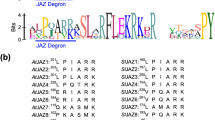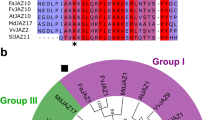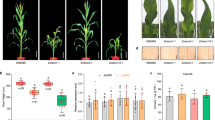Abstract
Jasmonates are a family of plant hormones that regulate plant growth, development and responses to stress. The F-box protein CORONATINE INSENSITIVE 1 (COI1) mediates jasmonate signalling by promoting hormone-dependent ubiquitylation and degradation of transcriptional repressor JAZ proteins. Despite its importance, the mechanism of jasmonate perception remains unclear. Here we present structural and pharmacological data to show that the true Arabidopsis jasmonate receptor is a complex of both COI1 and JAZ. COI1 contains an open pocket that recognizes the bioactive hormone (3R,7S)-jasmonoyl-l-isoleucine (JA-Ile) with high specificity. High-affinity hormone binding requires a bipartite JAZ degron sequence consisting of a conserved α-helix for COI1 docking and a loop region to trap the hormone in its binding pocket. In addition, we identify a third critical component of the jasmonate co-receptor complex, inositol pentakisphosphate, which interacts with both COI1 and JAZ adjacent to the ligand. Our results unravel the mechanism of jasmonate perception and highlight the ability of F-box proteins to evolve as multi-component signalling hubs.
This is a preview of subscription content, access via your institution
Access options
Subscribe to this journal
Receive 51 print issues and online access
$199.00 per year
only $3.90 per issue
Buy this article
- Purchase on Springer Link
- Instant access to full article PDF
Prices may be subject to local taxes which are calculated during checkout





Similar content being viewed by others
References
Browse, J. Jasmonate passes muster: a receptor and targets for the defense hormone. Annu. Rev. Plant Biol. 60, 183–205 (2009)
Feys, B., Benedetti, C. E., Penfold, C. N. & Turner, J. G. Arabidopsis mutants selected for resistance to the phytotoxin coronatine are male sterile, insensitive to methyl jasmonate, and resistant to a bacterial pathogen. Plant Cell 6, 751–759 (1994)
Staswick, P. E. & Tiryaki, I. The oxylipin signal jasmonic acid is activated by an enzyme that conjugates it to isoleucine in Arabidopsis. Plant Cell 16, 2117–2127 (2004)
Fonseca, S. et al. (+)-7-iso-Jasmonoyl-L-isoleucine is the endogenous bioactive jasmonate. Nature Chem. Biol. 5, 344–350 (2009)
Xie, D. X., Feys, B. F., James, S., Nieto-Rostro, M. & Turner, J. G. COI1: an Arabidopsis gene required for jasmonate-regulated defense and fertility. Science 280, 1091–1094 (1998)
Chini, A. et al. The JAZ family of repressors is the missing link in jasmonate signalling. Nature 448, 666–671 (2007)
Thines, B. et al. JAZ repressor proteins are targets of the SCFCOI1 complex during jasmonate signalling. Nature 448, 661–665 (2007)
Yan, Y. et al. A downstream mediator in the growth repression limb of the jasmonate pathway. Plant Cell 19, 2470–2483 (2007)
Lorenzo, O., Chico, J. M., Sanchez-Serrano, J. J. & Solano, R. JASMONATE-INSENSITIVE1 encodes a MYC transcription factor essential to discriminate between different jasmonate-regulated defense responses in Arabidopsis. Plant Cell 16, 1938–1950 (2004)
Kepinski, S. & Leyser, O. The Arabidopsis F-box protein TIR1 is an auxin receptor. Nature 435, 446–451 (2005)
Dharmasiri, N., Dharmasiri, S. & Estelle, M. The F-box protein TIR1 is an auxin receptor. Nature 435, 441–445 (2005)
Yan, J. et al. The Arabidopsis CORONATINE INSENSITIVE1 protein is a jasmonate receptor. Plant Cell 21, 2220–2236 (2009)
Katsir, L., Schilmiller, A. L., Staswick, P. E., He, S. Y. & Howe, G. A. COI1 is a critical component of a receptor for jasmonate and the bacterial virulence factor coronatine. Proc. Natl Acad. Sci. USA 105, 7100–7105 (2008)
Suza, W. P. & Staswick, P. E. The role of JAR1 in jasmonoyl-L-isoleucine production during Arabidopsis wound response. Planta 227, 1221–1232 (2008)
Koo, A. J., Gao, X., Jones, A. D. & Howe, G. A. A rapid wound signal activates the systemic synthesis of bioactive jasmonates in Arabidopsis. Plant J. 59, 974–986 (2009)
Chung, H. S. & Howe, G. A. A critical role for the TIFY motif in repression of jasmonate signaling by a stabilized splice variant of the JASMONATE ZIM-domain protein JAZ10 in Arabidopsis. Plant Cell 21, 131–145 (2009)
Melotto, M. et al. A critical role of two positively charged amino acids in the Jas motif of Arabidopsis JAZ proteins in mediating coronatine- and jasmonoyl isoleucine-dependent interactions with the COI1 F-box protein. Plant J. 55, 979–988 (2008)
Grunewald, W. et al. Expression of the Arabidopsis jasmonate signalling repressor JAZ1/TIFY10A is stimulated by auxin. EMBO Rep. 10, 923–928 (2009)
Chung, H. S. et al. Alternative splicing expands the repertoire of dominant JAZ repressors of jasmonate signaling. Plant J. 63, 613–622 (2010)
Tan, X. et al. Mechanism of auxin perception by the TIR1 ubiquitin ligase. Nature 446, 640–645 (2007)
Stephens, L. R. et al. myo-inositol pentakisphosphates. Structure, biological occurrence and phosphorylation to myo-inositol hexakisphosphate. Biochem. J. 275, 485–499 (1991)
Shimada, A. et al. Structural basis for gibberellin recognition by its receptor GID1. Nature 456, 520–523 (2008)
Murase, K., Hirano, Y., Sun, T. P. & Hakoshima, T. Gibberellin-induced DELLA recognition by the gibberellin receptor GID1. Nature 456, 459–463 (2008)
Santiago, J. et al. The abscisic acid receptor PYR1 in complex with abscisic acid. Nature 462, 665–668 (2009)
Melcher, K. et al. A gate-latch-lock mechanism for hormone signalling by abscisic acid receptors. Nature 462, 602–608 (2009)
Miyazono, K. et al. Structural basis of abscisic acid signalling. Nature 462, 609–614 (2009)
Nishimura, N. et al. Structural mechanism of abscisic acid binding and signaling by dimeric PYR1. Science 326, 1373–1379 (2009)
Yin, P. et al. Structural insights into the mechanism of abscisic acid signaling by PYL proteins. Nature Struct. Mol. Biol. 16, 1230–1236 (2009)
Otwinowski, Z. & Minor, W. in Methods in Enzymology Vol. 276 (eds Carter, C. W. & Sweet, R. M.) 307–326 (Academic, 1997)
Adams, P. D. et al. PHENIX: building new software for automated crystallographic structure determination. Acta Crystallogr. D 58, 1948–1954 (2002)
Jones, T. A., Zou, J. Y., Cowan, S. W. & Kjeldgaard, M. Improved methods for building protein models in electron density maps and the location of errors in these models. Acta Crystallogr. A 47, 110–119 (1991)
Brünger, A. T. et al. Crystallography & NMR system: A new software suite for macromolecular structure determination. Acta Crystallogr. D 54, 905–921 (1998)
Ogawa, N. & Kobayashi, Y. Strategy for synthesis of the isoleucine conjugate of epi-jasmonic acid. Tetrahedr. Lett. 49, 7124–7127 (2008)
Cheng, Y. & Prusoff, W. H. Relationship between the inhibition constant (K 1) and the concentration of inhibitor which causes 50 per cent inhibition (I50) of an enzymatic reaction. Biochem. Pharmacol. 22, 3099–3108 (1973)
Sadrzadeh, S. M., Vincenzi, F. F. & Hinds, T. R. Simultaneous measurement of multiple membrane ATPases in microtiter plates. J. Pharmacol. Toxicol. Methods 30, 103–110 (1993)
Nettleton, E. J. et al. Protein subunit interactions and structural integrity of amyloidogenic transthyretins: evidence from electrospray mass spectrometry. J. Mol. Biol. 281, 553–564 (1998)
Delaglio, F. et al. NMRPipe: a multidimensional spectral processing system based on UNIX pipes. J. Biomol. NMR 6, 277–293 (1995)
Johnson, B. A. Using NMRView to visualize and analyze the NMR spectra of macromolecules. Methods Mol. Biol. 278, 313–352 (2004)
Acknowledgements
We thank the beamline staff of the Advanced Light Source at the University of California at Berkeley and the Advanced Photon Source at Argonne National Laboratory for help with data collection. We also thank P. Rajagopal and R. Klevit for 31P NMR analysis, M. Sadilek for mass spectrometry analysis, L. Katsir, C. Hague and J. Lyssand for radioligand binding assay assistance, and C. Mecey and M. Melotto for initial cloning of coi1(sdm) mutants. We also thank members of the Zheng laboratory and W. Xu laboratory and R. Gardner for discussion and help. This work is supported by the Howard Hughes Medical Institute and grants from the National Institutes of Health (R01 CA107134 to N.Z., T32 GM07270 to L.B.S., R01GM57795 to G.A.H., R01AI068718 to S.Y.H.), National Science Foundation (0929100 to N.Z.), US Department of Energy (DE-FG02-99ER20323 to J.B. and DE-FG02-91ER20021 to G.A.H. and S.Y.H.), Michigan State University Plant Science Fellowship (J.W.), the Welch Foundation (I-1304 to J.R.) and the European Research Council (ERC) under the European Community’s Seventh Framework Program (FP7/2007-2013)/ ERC Grant agreement no. 239679 (G.B.-N. and M.S.).
Author information
Authors and Affiliations
Contributions
L.B.S., G.A.H. and N.Z. conceived and L.B.S. conducted radioligand binding and additional functional experiments. X.T., H.M. and L.B.S. purified the COI1–ASK1 complex and conducted crystallographic experiments. X.T. crystallized and determined the structures of the COI1–ASK1–JAZ1 hormone complexes. L.B.S., X.T. and N.Z. analysed crystallographic data. J.W. and S.Y.H. conceived and J.W. conducted yeast two-hybrid experiments. G.B.-N. and M.S. conducted and interpreted the structural mass spectrometry experiments. L.B.S., H.M., T.R.H., F.-F.H., J.R. and N.Z. conceived and conducted experiments for inositol phosphate purification and identification. Y.K. synthesized jasmonate stereoisomers. L.B.S. and N.Z. wrote the manuscript with comments from all authors.
Corresponding author
Ethics declarations
Competing interests
The authors declare no competing financial interests.
Supplementary information
Supplementary Information
This file contains Supplementary Figures 1-8 with legends and Supplementary Table 1. (PDF 2416 kb)
Rights and permissions
About this article
Cite this article
Sheard, L., Tan, X., Mao, H. et al. Jasmonate perception by inositol-phosphate-potentiated COI1–JAZ co-receptor. Nature 468, 400–405 (2010). https://doi.org/10.1038/nature09430
Received:
Accepted:
Published:
Issue Date:
DOI: https://doi.org/10.1038/nature09430
This article is cited by
-
In-vitro and in-silico studies on plant growth promotion of endophytic fungi of Ischaemum ciliare Retz.
Journal of Plant Pathology (2024)
-
The N-terminal α2 helix element is critical for the activity of the rice transcription factor MYC2
Plant Molecular Biology (2024)
-
Mechanisms of systemic resistance to pathogen infection in plants and their potential application in forestry
BMC Plant Biology (2023)
-
Jasmonate signaling drives defense responses against Alternaria alternata in chrysanthemum
BMC Genomics (2023)
-
NLR surveillance of pathogen interference with hormone receptors induces immunity
Nature (2023)
Comments
By submitting a comment you agree to abide by our Terms and Community Guidelines. If you find something abusive or that does not comply with our terms or guidelines please flag it as inappropriate.



